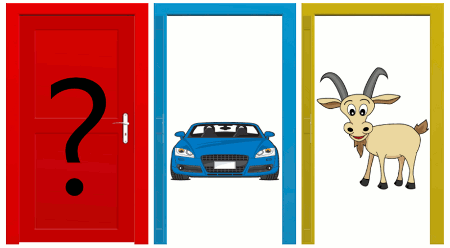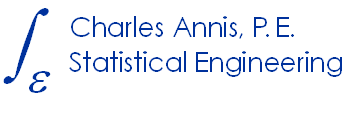Monty Hall Problem Explained
It only seems like it shouldn’t make a difference to switch doors. Here’s why switching doors wins twice as often. No fancy math necessary!

You know the setup:
There are three doors. Behind one is a wonderful prize. Behind the other two, a goat. You get to choose which of the three doors you want. Then the host (Monte Hall) opens one of the doors you didn’t choose, and reveals … a goat.
Now you are offered a chance to switch from your original choice to the unopened door you did not choose. Should you switch?
You probably know the answer is yes, switch, but haven’t seen a simple explanation why. It surely seems as though it shouldn’t matter, but it does. Switching will double you chance of winning. How can this be?Here is where we could get into some fancy arithmetic using Bayes Theorem – but we won’t. There a much easier way to see what’s happening.
Bayes Explanation:
My intention was to provide a multi-step Bayesian explanation here to illustrate how complicated Bayes Theorem can be in practice – even for something that appears straight-forward. But what I demonstrated was more philosophical than illuminating, so you will have to find a Bayesian explanation elsewhere. (There are many.)
For example, there is some discussion concerning how to set the problem up for a Bayesian analysis, but these discussions illustrate more how statisticians can make a simple problem complicated, than to illuminate the original problem.
One argument concerns what probability to assign to the host’s opening which door. The reality is that \(prob(door\;with\;goat) = 100%\). (Otherwise, what’s the point?)
Actually for any realistic statement of the problem, the Bayesian construct focuses on the same thing: two chances rather than one.
Another point of view:
The Monty Hall problem is much like a slight-of-hand magic trick: You are distracted from seeing what is actually happening so it looks different from what it actually is. To prove that I will set up the problem the same way but this time I’ll leave out all the stuff that’s there just to throw you off:
There are three doors, and you are given the choice of having what is behind one of the doors, or what is behind two of the doors. Which do you choose – one door or two? Of course you would choose having two doors, so I will muddy the water a bit.
You can only choose one door and Monty gets the other two. Now, do you want to switch with him and trade your one door for his two? Of course you do. So I’ll try to confuse you some more:
Before giving you the choice of switching one door for two, Monty will show you that one of his two doors has a goat behind it. Well, of course it does – there is only one prize and he has two doors. But since he had two doors to begin with, he has 2 chances out of 3 to have the prize. You only have 1 chance out of 3. Showing you that one of the doors isn’t the prize tells you nothing. You already knew that one of the doors concealed a goat. All that folderol is just to confuse you.
Do you want to switch now – or has all my arm-waving succeeded in confusing you?
You switch. Why? Because it all boils down to choosing 2 doors rather than 1. It’s that simple. All that other stuff is window-dressing designed to mislead you.

